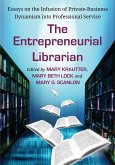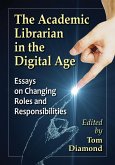Genealogy and the Librarian
Perspectives on Research, Instruction, Outreach and Management
Herausgeber: Smallwood, Carol; Gubnitskaia, Vera
Genealogy and the Librarian
Perspectives on Research, Instruction, Outreach and Management
Herausgeber: Smallwood, Carol; Gubnitskaia, Vera
- Broschiertes Buch
- Merkliste
- Auf die Merkliste
- Bewerten Bewerten
- Teilen
- Produkt teilen
- Produkterinnerung
- Produkterinnerung
Covering trends, issues and case studies, this collection presents 34 new essays by library professionals actively engaged in helping patrons with genealogy research across the United States. Topics include strategies for finding military and court records, mapping family migration and settlement, creating and accessing local digital services, and developing materials and instruction for patrons. Forewordist D. Joshua Taylor, host of Genealogy Roadshow and president of the New York Genealogical and Biographical Society, notes: "The increasing popularity of the topic requires that any librarian…mehr
Andere Kunden interessierten sich auch für
![Job Stress and the Librarian Job Stress and the Librarian]() Job Stress and the Librarian57,99 €
Job Stress and the Librarian57,99 €![The Entrepreneurial Librarian The Entrepreneurial Librarian]() The Entrepreneurial Librarian58,99 €
The Entrepreneurial Librarian58,99 €![The New Academic Librarian The New Academic Librarian]() The New Academic Librarian57,99 €
The New Academic Librarian57,99 €![Reading and the Reference Librarian Reading and the Reference Librarian]() Juris DilevkoReading and the Reference Librarian52,99 €
Juris DilevkoReading and the Reference Librarian52,99 €![The Academic Librarian in the Digital Age The Academic Librarian in the Digital Age]() The Academic Librarian in the Digital Age58,99 €
The Academic Librarian in the Digital Age58,99 €![The Faithful Librarian The Faithful Librarian]() The Faithful Librarian57,99 €
The Faithful Librarian57,99 €![The Generation X Librarian The Generation X Librarian]() The Generation X Librarian57,99 €
The Generation X Librarian57,99 €-
-
-
Covering trends, issues and case studies, this collection presents 34 new essays by library professionals actively engaged in helping patrons with genealogy research across the United States. Topics include strategies for finding military and court records, mapping family migration and settlement, creating and accessing local digital services, and developing materials and instruction for patrons. Forewordist D. Joshua Taylor, host of Genealogy Roadshow and president of the New York Genealogical and Biographical Society, notes: "The increasing popularity of the topic requires that any librarian who encounters genealogical customers remain on the forefront of new developments in the field."
Produktdetails
- Produktdetails
- Verlag: McFarland
- Seitenzahl: 302
- Erscheinungstermin: 14. Juni 2018
- Englisch
- Abmessung: 254mm x 178mm x 16mm
- Gewicht: 572g
- ISBN-13: 9781476670874
- ISBN-10: 1476670870
- Artikelnr.: 50508176
- Herstellerkennzeichnung
- Libri GmbH
- Europaallee 1
- 36244 Bad Hersfeld
- gpsr@libri.de
- Verlag: McFarland
- Seitenzahl: 302
- Erscheinungstermin: 14. Juni 2018
- Englisch
- Abmessung: 254mm x 178mm x 16mm
- Gewicht: 572g
- ISBN-13: 9781476670874
- ISBN-10: 1476670870
- Artikelnr.: 50508176
- Herstellerkennzeichnung
- Libri GmbH
- Europaallee 1
- 36244 Bad Hersfeld
- gpsr@libri.de
A Michigan resident, Carol Smallwood has practiced in school, public and special libraries. Her primary interest is practical librarianship, and she is the author of journal articles and editor of numerous books. Vera Gubnitskaia has worked as a library manager, consultant, and reference librarian in public and academic libraries in Russia and the United States. She has contributed chapters to several professional publications, edited multiple anthologies, and published book reviews. She is currently an art fellow at Crealde School in Winter Park, Florida.
Table of Contents
Foreword (D. Joshua Taylor)
Preface (Carol Smallwood and Vera Gubnitskaia)
Part I: Overview
Trends in Genealogy (Charlene Garcia Simms)
The Future of the Past: How Chronicling America Can Impact
Genealogical Stories (Robin C. Pike, Anna J. Kephart and Douglas McElrath)
Something Old, Something New: Reviving Traditional Editing Tools
in the Digital Age (Debra Carrier Bloom)
The Rest Is History: Using Historical Resources to Enrich Genealogy Results
(Tracy Carr)
The Affective Nature of Genealogy Collections: New Narratives Through the
Altered Book (Anastasia Varnalis Weigle and Renée L. DesRoberts)
Part II: Collaboration
A Genealogy Digitization Collaboration (Ben Walker and Chelsea S. Dinsmore)
Destined for the Dumpster: A Collaboration Between Librarians
and Genealogists to Make 79,000 At-Risk Records Available
for Research (Joanne M. Riley, Jessica Holden and Susan Steele)
Community Engagement Stimulates Collaboration and Innovation
for Local History and Genealogy Programming to Public Housing
Residents (Roland Barksdale-Hall)
Building a Collaborative Partnership Between a Genealogical Society
and a Public Library (Anastasia Varnalis Weigle, Wendy Lombard Bossie and
Brenda Jackson Bourgoine)
Part III: Case Studies
Making the Case for Genealogy Reference Instruction (Lisa A. Oberg)
Introducing Genealogy to the Academic Library in the 21st Century
(Thomas McFarland and Joan M. Barnes)
Part IV: Research
Finding Military and Court Records: Strategies for Research
(Rosemary L. Meszaros and Katherine Pennavaria)
Contemporary Chinese Genealogy: Value and Status in Academic
Research and Library Collection (Hong Cheng)
Supporting Genealogists in Oral History Research: The Role
of the Library (Noah Lenstra)
Preparing for Genealogical Reference Work (Beth Stahr)
Part V: Instruction
Education Techniques for Genealogy Instruction (Carmen Nigro)
Instructing Patrons on Using Free Online Genealogical Resources (Andrew
Hart)
Special Collections Librarians Assisting Patrons in Finding and Preserving
Family History (Nancy Richey)
Beyond Names and Dates on a Tree: How Librarians Can Help Explore Family
Heritage and Preservation (Barry L. Stiefel)
Finding Death-Related Records: Strategies for Research
(Katherine Pennavaria and Rosemary L. Meszaros)
Genealogy Literacy: Helping Patrons Build Stable Trees Through Information
Literacy Standards (Cheri J. Daniels)
Part VI: Family
Finding Family, Friends, Neighbors and Community in Patent Records
(Barbara J. Hampton)
Putting Family History on the Map: Creating Visual Representations
of Family Migration, Settlement and Encounters (Leslie A. Wagner)
Part VII: Outreach
Genealogy Behind Bars: Professional Development Through Prisoner
Requests, a Case Study (Kathrine C. Aydelott)
Community Outreach: Making Your Collection Known and Used
(Larry Naukam)
Crowdsourcing Genealogy with Tea and Sympathy: Outreach Approaches That
Instruct and Engage (Cheri J. Daniels)
Part VIII: Management
Accessing and Creating Local Digital Services for Genealogy
(Rhonda L. Clark)
Genealogy for Academics: Utilizing Genealogy Resources for More
Than Family History (Nancy A. Bunker and Jenny L. Presnell)
The Butler County Obituary and Newspaper Index: An Example
of Genealogy Database Creation and Ongoing Management
(Margaret E. Hewitt)
Digitize Your Old Media: A Self-Service Station for Public Library Patrons
(Kirsten Canfield)
Crowdsourcing Genealogy: Evaluating Sources in the Age of Ancestry.com
(Kathrine C. Aydelott)
Doing Your Data Digitally-Why and How (Larry Naukam)
Part IX: Finances
Grants: Finding, Writing and Following Through
Natalie Bazan Starosta
Developing Materials and Instruction on a Budget for Local Patrons
Janet Curtiss
About the Contributors
Index
Foreword (D. Joshua Taylor)
Preface (Carol Smallwood and Vera Gubnitskaia)
Part I: Overview
Trends in Genealogy (Charlene Garcia Simms)
The Future of the Past: How Chronicling America Can Impact
Genealogical Stories (Robin C. Pike, Anna J. Kephart and Douglas McElrath)
Something Old, Something New: Reviving Traditional Editing Tools
in the Digital Age (Debra Carrier Bloom)
The Rest Is History: Using Historical Resources to Enrich Genealogy Results
(Tracy Carr)
The Affective Nature of Genealogy Collections: New Narratives Through the
Altered Book (Anastasia Varnalis Weigle and Renée L. DesRoberts)
Part II: Collaboration
A Genealogy Digitization Collaboration (Ben Walker and Chelsea S. Dinsmore)
Destined for the Dumpster: A Collaboration Between Librarians
and Genealogists to Make 79,000 At-Risk Records Available
for Research (Joanne M. Riley, Jessica Holden and Susan Steele)
Community Engagement Stimulates Collaboration and Innovation
for Local History and Genealogy Programming to Public Housing
Residents (Roland Barksdale-Hall)
Building a Collaborative Partnership Between a Genealogical Society
and a Public Library (Anastasia Varnalis Weigle, Wendy Lombard Bossie and
Brenda Jackson Bourgoine)
Part III: Case Studies
Making the Case for Genealogy Reference Instruction (Lisa A. Oberg)
Introducing Genealogy to the Academic Library in the 21st Century
(Thomas McFarland and Joan M. Barnes)
Part IV: Research
Finding Military and Court Records: Strategies for Research
(Rosemary L. Meszaros and Katherine Pennavaria)
Contemporary Chinese Genealogy: Value and Status in Academic
Research and Library Collection (Hong Cheng)
Supporting Genealogists in Oral History Research: The Role
of the Library (Noah Lenstra)
Preparing for Genealogical Reference Work (Beth Stahr)
Part V: Instruction
Education Techniques for Genealogy Instruction (Carmen Nigro)
Instructing Patrons on Using Free Online Genealogical Resources (Andrew
Hart)
Special Collections Librarians Assisting Patrons in Finding and Preserving
Family History (Nancy Richey)
Beyond Names and Dates on a Tree: How Librarians Can Help Explore Family
Heritage and Preservation (Barry L. Stiefel)
Finding Death-Related Records: Strategies for Research
(Katherine Pennavaria and Rosemary L. Meszaros)
Genealogy Literacy: Helping Patrons Build Stable Trees Through Information
Literacy Standards (Cheri J. Daniels)
Part VI: Family
Finding Family, Friends, Neighbors and Community in Patent Records
(Barbara J. Hampton)
Putting Family History on the Map: Creating Visual Representations
of Family Migration, Settlement and Encounters (Leslie A. Wagner)
Part VII: Outreach
Genealogy Behind Bars: Professional Development Through Prisoner
Requests, a Case Study (Kathrine C. Aydelott)
Community Outreach: Making Your Collection Known and Used
(Larry Naukam)
Crowdsourcing Genealogy with Tea and Sympathy: Outreach Approaches That
Instruct and Engage (Cheri J. Daniels)
Part VIII: Management
Accessing and Creating Local Digital Services for Genealogy
(Rhonda L. Clark)
Genealogy for Academics: Utilizing Genealogy Resources for More
Than Family History (Nancy A. Bunker and Jenny L. Presnell)
The Butler County Obituary and Newspaper Index: An Example
of Genealogy Database Creation and Ongoing Management
(Margaret E. Hewitt)
Digitize Your Old Media: A Self-Service Station for Public Library Patrons
(Kirsten Canfield)
Crowdsourcing Genealogy: Evaluating Sources in the Age of Ancestry.com
(Kathrine C. Aydelott)
Doing Your Data Digitally-Why and How (Larry Naukam)
Part IX: Finances
Grants: Finding, Writing and Following Through
Natalie Bazan Starosta
Developing Materials and Instruction on a Budget for Local Patrons
Janet Curtiss
About the Contributors
Index
Table of Contents
Foreword (D. Joshua Taylor)
Preface (Carol Smallwood and Vera Gubnitskaia)
Part I: Overview
Trends in Genealogy (Charlene Garcia Simms)
The Future of the Past: How Chronicling America Can Impact
Genealogical Stories (Robin C. Pike, Anna J. Kephart and Douglas McElrath)
Something Old, Something New: Reviving Traditional Editing Tools
in the Digital Age (Debra Carrier Bloom)
The Rest Is History: Using Historical Resources to Enrich Genealogy Results
(Tracy Carr)
The Affective Nature of Genealogy Collections: New Narratives Through the
Altered Book (Anastasia Varnalis Weigle and Renée L. DesRoberts)
Part II: Collaboration
A Genealogy Digitization Collaboration (Ben Walker and Chelsea S. Dinsmore)
Destined for the Dumpster: A Collaboration Between Librarians
and Genealogists to Make 79,000 At-Risk Records Available
for Research (Joanne M. Riley, Jessica Holden and Susan Steele)
Community Engagement Stimulates Collaboration and Innovation
for Local History and Genealogy Programming to Public Housing
Residents (Roland Barksdale-Hall)
Building a Collaborative Partnership Between a Genealogical Society
and a Public Library (Anastasia Varnalis Weigle, Wendy Lombard Bossie and
Brenda Jackson Bourgoine)
Part III: Case Studies
Making the Case for Genealogy Reference Instruction (Lisa A. Oberg)
Introducing Genealogy to the Academic Library in the 21st Century
(Thomas McFarland and Joan M. Barnes)
Part IV: Research
Finding Military and Court Records: Strategies for Research
(Rosemary L. Meszaros and Katherine Pennavaria)
Contemporary Chinese Genealogy: Value and Status in Academic
Research and Library Collection (Hong Cheng)
Supporting Genealogists in Oral History Research: The Role
of the Library (Noah Lenstra)
Preparing for Genealogical Reference Work (Beth Stahr)
Part V: Instruction
Education Techniques for Genealogy Instruction (Carmen Nigro)
Instructing Patrons on Using Free Online Genealogical Resources (Andrew
Hart)
Special Collections Librarians Assisting Patrons in Finding and Preserving
Family History (Nancy Richey)
Beyond Names and Dates on a Tree: How Librarians Can Help Explore Family
Heritage and Preservation (Barry L. Stiefel)
Finding Death-Related Records: Strategies for Research
(Katherine Pennavaria and Rosemary L. Meszaros)
Genealogy Literacy: Helping Patrons Build Stable Trees Through Information
Literacy Standards (Cheri J. Daniels)
Part VI: Family
Finding Family, Friends, Neighbors and Community in Patent Records
(Barbara J. Hampton)
Putting Family History on the Map: Creating Visual Representations
of Family Migration, Settlement and Encounters (Leslie A. Wagner)
Part VII: Outreach
Genealogy Behind Bars: Professional Development Through Prisoner
Requests, a Case Study (Kathrine C. Aydelott)
Community Outreach: Making Your Collection Known and Used
(Larry Naukam)
Crowdsourcing Genealogy with Tea and Sympathy: Outreach Approaches That
Instruct and Engage (Cheri J. Daniels)
Part VIII: Management
Accessing and Creating Local Digital Services for Genealogy
(Rhonda L. Clark)
Genealogy for Academics: Utilizing Genealogy Resources for More
Than Family History (Nancy A. Bunker and Jenny L. Presnell)
The Butler County Obituary and Newspaper Index: An Example
of Genealogy Database Creation and Ongoing Management
(Margaret E. Hewitt)
Digitize Your Old Media: A Self-Service Station for Public Library Patrons
(Kirsten Canfield)
Crowdsourcing Genealogy: Evaluating Sources in the Age of Ancestry.com
(Kathrine C. Aydelott)
Doing Your Data Digitally-Why and How (Larry Naukam)
Part IX: Finances
Grants: Finding, Writing and Following Through
Natalie Bazan Starosta
Developing Materials and Instruction on a Budget for Local Patrons
Janet Curtiss
About the Contributors
Index
Foreword (D. Joshua Taylor)
Preface (Carol Smallwood and Vera Gubnitskaia)
Part I: Overview
Trends in Genealogy (Charlene Garcia Simms)
The Future of the Past: How Chronicling America Can Impact
Genealogical Stories (Robin C. Pike, Anna J. Kephart and Douglas McElrath)
Something Old, Something New: Reviving Traditional Editing Tools
in the Digital Age (Debra Carrier Bloom)
The Rest Is History: Using Historical Resources to Enrich Genealogy Results
(Tracy Carr)
The Affective Nature of Genealogy Collections: New Narratives Through the
Altered Book (Anastasia Varnalis Weigle and Renée L. DesRoberts)
Part II: Collaboration
A Genealogy Digitization Collaboration (Ben Walker and Chelsea S. Dinsmore)
Destined for the Dumpster: A Collaboration Between Librarians
and Genealogists to Make 79,000 At-Risk Records Available
for Research (Joanne M. Riley, Jessica Holden and Susan Steele)
Community Engagement Stimulates Collaboration and Innovation
for Local History and Genealogy Programming to Public Housing
Residents (Roland Barksdale-Hall)
Building a Collaborative Partnership Between a Genealogical Society
and a Public Library (Anastasia Varnalis Weigle, Wendy Lombard Bossie and
Brenda Jackson Bourgoine)
Part III: Case Studies
Making the Case for Genealogy Reference Instruction (Lisa A. Oberg)
Introducing Genealogy to the Academic Library in the 21st Century
(Thomas McFarland and Joan M. Barnes)
Part IV: Research
Finding Military and Court Records: Strategies for Research
(Rosemary L. Meszaros and Katherine Pennavaria)
Contemporary Chinese Genealogy: Value and Status in Academic
Research and Library Collection (Hong Cheng)
Supporting Genealogists in Oral History Research: The Role
of the Library (Noah Lenstra)
Preparing for Genealogical Reference Work (Beth Stahr)
Part V: Instruction
Education Techniques for Genealogy Instruction (Carmen Nigro)
Instructing Patrons on Using Free Online Genealogical Resources (Andrew
Hart)
Special Collections Librarians Assisting Patrons in Finding and Preserving
Family History (Nancy Richey)
Beyond Names and Dates on a Tree: How Librarians Can Help Explore Family
Heritage and Preservation (Barry L. Stiefel)
Finding Death-Related Records: Strategies for Research
(Katherine Pennavaria and Rosemary L. Meszaros)
Genealogy Literacy: Helping Patrons Build Stable Trees Through Information
Literacy Standards (Cheri J. Daniels)
Part VI: Family
Finding Family, Friends, Neighbors and Community in Patent Records
(Barbara J. Hampton)
Putting Family History on the Map: Creating Visual Representations
of Family Migration, Settlement and Encounters (Leslie A. Wagner)
Part VII: Outreach
Genealogy Behind Bars: Professional Development Through Prisoner
Requests, a Case Study (Kathrine C. Aydelott)
Community Outreach: Making Your Collection Known and Used
(Larry Naukam)
Crowdsourcing Genealogy with Tea and Sympathy: Outreach Approaches That
Instruct and Engage (Cheri J. Daniels)
Part VIII: Management
Accessing and Creating Local Digital Services for Genealogy
(Rhonda L. Clark)
Genealogy for Academics: Utilizing Genealogy Resources for More
Than Family History (Nancy A. Bunker and Jenny L. Presnell)
The Butler County Obituary and Newspaper Index: An Example
of Genealogy Database Creation and Ongoing Management
(Margaret E. Hewitt)
Digitize Your Old Media: A Self-Service Station for Public Library Patrons
(Kirsten Canfield)
Crowdsourcing Genealogy: Evaluating Sources in the Age of Ancestry.com
(Kathrine C. Aydelott)
Doing Your Data Digitally-Why and How (Larry Naukam)
Part IX: Finances
Grants: Finding, Writing and Following Through
Natalie Bazan Starosta
Developing Materials and Instruction on a Budget for Local Patrons
Janet Curtiss
About the Contributors
Index








